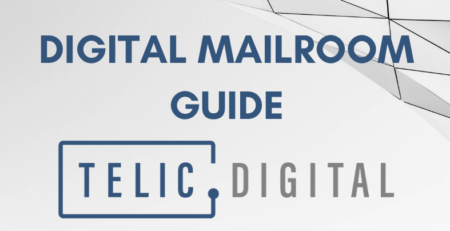Digital Mailroom: Don’t Forget About Email
The effects of 2020 will no doubt have a long-standing effect on the shape of the economy and working practices for many years to come. Businesses and organisations have had to adapt at record pace, accelerating digital transformation activities and projects, that in more ‘normal’ times would have taken years to plan and act on. Digital Mailroom solutions for email have never been more relevant.
In accelerating these projects, it has been necessary to think and behave tactically, addressing the challenges of the here and now, as opposed to taking a more long-term and strategic view. The obvious challenges of a physical mailroom were seen as how to get physical communications coming into offices to the hands of knowledge workers who in the main were based at home. Re-routing physical post to individuals’ private residences, has no doubt happened in some instances, but for most organisations is not only impractical, but tears up the rule book around information governance.
So, the obvious step for most organisations will have been to utilise scanning technology to digitise inbound postal items and route these to staff members to work on, AKA a Digital Mailroom. In many cases, the quickest way to address this will be have been to re-route the post to a scanning service provider, who would commit to a service level agreement, to open, scan, and route digital images to a shared location that staff can access.
This all sounds sensible so far, but what else has changed this year. Well, for a start, print volumes across all organisations have reduced dramatically. A study by Keypoint Intelligence, suggests in the US alone, print volumes will be down by 80 billion pages this year. Now some of this will clearly be internal printing but a large proportion will have been printed for sending out for reception in other organisations’ mailrooms.
So if its not being printed, what’s happening? Are organisations just needing to send less? Sure, there are the impacts of reduced trading and the associated drops in business activities, but are alternatives being found to the once primary route for sending more official types of correspondence.
Cisco report that global email volumes, excluding spam, in January this year were at 47 billion emails per day. In August that had risen to 62 billion emails per day, up by over 30%. Staggering numbers in themselves! The intelligence of what is in these emails and whether this increase will be sustained is not known, but it might not be too much of a jump to think a decline in print and post may have been shifted to email. Certainly, a number of organisations that we have spoken to over the past months, that have traditionally had a mix of physical and digital communications, are reporting that their teams are now almost exclusively working with email to handle inbound and outbound communication.
In some ways, this is helping organisations. Email comes with a number of obvious advantages over post; its faster, cheaper and easily moved around. However, these properties also make problems of their own. Common issues with handling emails stem from the inability to properly track and manage email communications; increasing the likelihood of duplication, missing of service level agreements and potentially losing information altogether. This can lead to poor customer service, increased costs and the inability to really see what is going on in a process for management and future decision making. After all, email platforms are designed as a method of exchanging electronic messages between people, not as an alternative to effective case management.
A frequent example of the sticky plaster approach to solving email overload and the management of emails passing through internal teams is the use of team inboxes, coloured categories and flags in the email client. This all sounds good, and probably helps as an initial way of dealing with the deluge of emails being received. It’s certainly better than the alternative of printing out emails to handle them – sounds crazy but it happens more often than you might think! However, colour coding and flags doesn’t necessarily provide the business with a truly strategic way forward. Using a technology platform to handle your team inbox emails correctly delivers a number of important advantages:
- Early Visibility – A Digital Mailroom will capture emails as soon as they are received and ensure they are worked on in appropriate timeframes. Once ingested emails can’t be accidently deleted or spend an eternity being bounced backwards and forwards across internal teams.
- Auditability – See what has happened with any email, who had done what and when.
- Insight for Process Improvement – Use data from the process to provide the business with insights into what has been happening and present this in a way that the organisation can make decisions that will enhance productivity and effectiveness.
- Opportunities for Automation – By better understanding the process and what is happening with emails, it becomes much easier to make informed decisions on where automation may play a role in automatically classifying content, extracting data, driving electronic workflows and updating internal systems.
- Improve User Experience – With more remote working its imperative that teams have the right tools at their disposal to ensure they can work effectively. By providing an intuitive interface that auto allocates work and guides them through a standardised process it means that its easier to gauge productivity and ensure engagement.
Digital Mailroom Do’s and Don’ts
- Do – Make sure your digital mailroom automation solution will handle multiple channels – paper, email and other electronic formats
- Don’t – Have separate processes for physical and digital correspondence
- Do – Think about inbound and outbound processes
- Don’t – Print emails!
- Do – Solve the tactical problems of today, but have an eye on the strategic role of true digital mailroom solutions for tomorrow
In an era, where everyone is digitally connected more than ever and that email is often seen as the official digital communication channel over and above various channels like Slack, Teams, Trello etc, it’s unlikely that email use will decline anytime soon. If anything, if recent times are anything to go by, it’s use will continue to grow until something else exists which is universally available, low cost and used by the global majority.
Further information on Digital Mailrooms can be found here, Download the Digital Mailroom Datasheet and the relative benefits are also discussed in this post, Reduce Paper and another 21 Benefits of a Digital Mailroom
For more further assistance understanding the potential for using a Digital Mailroom for Email in your organisation, please contact our experienced team who will be happy to assist, contact us here









